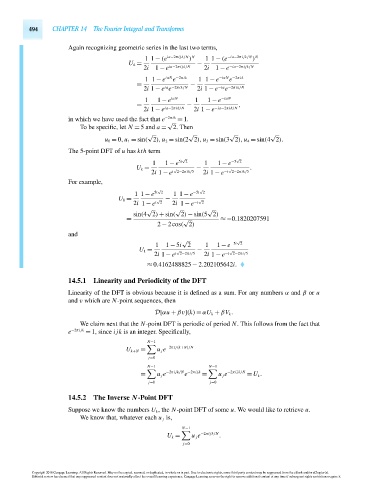Page 514 - Advanced engineering mathematics
P. 514
494 CHAPTER 14 The Fourier Integral and Transforms
Again recognizing geometric series in the last two terms,
1 1 − (e ia−2πijk/N N 1 1 − (e −ia−2πijk/N N
)
)
U k = −
2i 1 − e ia−2πijk/N 2i 1 − e −ia−2πijk/N
1 1 − e iaN −2πik 1 1 − e −iaN −2πik
e
e
= −
2i 1 − e e 2i 1 − e −ia −2πik/N
ia −2πik/N
e
1 1 − e iaN 1 1 − e −iaN
= − ,
2i 1 − e ia−2πik/N 2i 1 − e −ia−2πik/N
in which we have used the fact that e −2πik = 1.
√
To be specific, let N = 5 and a = 2. Then
√ √ √ √
u 0 = 0,u 1 = sin( 2),u 2 = sin(2 2),u 3 = sin(3 2),u 4 = sin(4 2).
The 5-point DFT of u has kth term
√ √
1 1 − e 5i 2 1 1 − e −5 2
U k = √ − √ .
2i 1 − e i 2−2πik/5 2i 1 − e −i 2−2πik/5
For example,
√ √
1 1 − e 5i 2 1 1 − e −5i 2
U 0 = √ − √
2i 1 − e i 2 2i 1 − e −i 2
√ √ √
sin(4 2) + sin( 2) − sin(5 2)
= √ ≈−0.1820207591
2 − 2cos( 2)
and
√ √
1 1 − 5i 2 1 1 − e −5i 2
U 1 = √ − √
2i 1 − e i 2−2πi/5 2i 1 − e −i 2−2πi/5
≈ 0.4162488825 − 2.202105642i.
14.5.1 Linearity and Periodicity of the DFT
Linearity of the DFT is obvious because it is defined as a sum. For any numbers α and β or u
and v which are N-point sequences, then
D[αu + βv](k) = αU k + βV k .
We claim next that the N-point DFT is periodic of period N. This follows from the fact that
e −2πijk = 1, since ijk is an integer. Specifically,
N−1
−2πij(k+N)/N
U k+N = u j e
j=0
N−1 N−1
e
= u j e −2πijk/N −2πijk = u j e −2πijk/N = U k .
j=0 j=0
14.5.2 The Inverse N-Point DFT
Suppose we know the numbers U k ,the N-point DFT of some u. We would like to retrieve u.
We know that, whatever each u j is,
N−1
U k = u j e −2πijk/N .
j=0
Copyright 2010 Cengage Learning. All Rights Reserved. May not be copied, scanned, or duplicated, in whole or in part. Due to electronic rights, some third party content may be suppressed from the eBook and/or eChapter(s).
Editorial review has deemed that any suppressed content does not materially affect the overall learning experience. Cengage Learning reserves the right to remove additional content at any time if subsequent rights restrictions require it.
October 14, 2010 16:43 THM/NEIL Page-494 27410_14_ch14_p465-504

